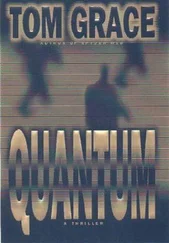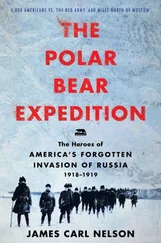‘Target lock is established.’
‘Fire,’ Duroc ordered.
A new line appeared in front of Kilkenny. This one was white and arcing upward from LV Station.
‘What the hell?’ Kilkenny blurted out, recognizing the launch of a surface-to-air missile.
‘COM on,’ he commanded. ‘Ice Jump One to Skier-Nine-Eight. Take evasive action! You have a missile inbound. Repeat, you have a missile inbound! Do you copy? Over.’
Static and feedback filled his ears. Faintly, buried beneath the electronic noise, he heard the pilot of Skier-98.
‘Say again, Ice Jump One. We’re not – ‘
The missile homed in on the heat radiating from the Allison engines. It approached at supersonic speed, easily running down the lumbering Hercules. As the missile struck the number three engine, its high-explosive war-head detonated with concussive fury. Hot metal fragments shredded Skier-98 ‘s aluminum skin and ignited the wing tanks.
‘COM off,’ Kilkenny commanded angrily, the range on his communications gear too short to reach anyone but the people who’d fired the missile. The static that filled his ears immediately vanished.
A black smudge marked the spot in the sky where Skier-98 had exploded, and smoky trails followed the descent of the burning wreckage to the ground – ominous stains on an otherwise perfect expanse of blue. Tilting his head toward the ground caused the bright yellow line of his flight path to reappear on the heads-up display.
He checked his altimeter. It read 26,750 feet. Kilkenny calculated his distance to the ice sheet below to be little more than 15,000 feet, just under three miles. With a lift-to-drag ratio of five-to-one, Kilkenny knew he might squeeze roughly fifteen miles of travel out of his ram-air parachute before gravity finally brought him down. As far as he could see, there was nothing but an endless expanse of ice.
‘I’ll be damned if I’m going to die here,’ Kilkenny vowed. ‘Clear flight path display.’
The bright yellow line vanished.
‘Display map.’
The outline of Antarctica appeared on the heads-up display.
‘Zoom in thirty-mile radius of current position. Display all stations.’
The image on the heads-up display raced toward Kilkenny – a greatly accelerated version of his present descent – and stopped at the specified magnification. Two labeled dots appeared on the display, one to either side of the X that marked his position.
Not going there, Kilkenny thought, looking at the dot labeled LV on the right.
He shifted his gaze to the other side of the display; beside the second dot he saw the letters VOS: Vostok Research Station.
Kilkenny knew little about the Russian research station, other than that it was dilapidated and ran on a shoestring budget. He considered the possibility that the Russians might be responsible for shooting down Skier-98, but couldn’t think of a reason compelling enough for them to risk starting World War Three in Antarctica.
Even with the SEALskin suit to keep him warm, Kilkenny had no food or water and the nearest U.S. outpost was several hundred miles away. Eliminating a suicide march across Antarctica, Kilkenny’s list of survival options shrank to one.
‘Clear map,’ Kilkenny commanded. ‘Reset destination point to Vostok Station.’
The computer calculated a new flight path and projected it on the heads-up display.
‘Twenty-five miles to Vostok,’ Kilkenny read off the display. ‘I should be able to fly fifteen of it, but the last ten are going to be on foot.’
Kilkenny banked his chute sharply into a welcome tailwind. In the bright polar daylight, he raced over the nearly flat surface of stark white ice, quickly accelerating past forty miles per hour. The only sound he heard was the wind whistling around his body.
He quickly fell into a familiar pattern: checking his chute, the horizon, and his altimeter. Five hundred feet above the ice, Kilkenny pulled down on the right control toggle and gradually turned his canopy into the wind. As his speed dropped off, Kilkenny pulled down evenly on both toggles and studied the ground below. The ice was now rushing up toward him. His altimeter rapidly counted down his descent, quickly passing through two hundred feet.
At one hundred feet, Kilkenny momentarily eased up on the toggles. The chute surged forward and his rate of fall slowed. An instinct borne from experience took over, and, at precisely the right moment, he pulled the control toggles down as far as they would go, and gently touched down on the icy plain that covered Lake Vostok.
Quickly, before the wind grabbed it, he unbuckled his harness and deflated the ram-air chute. He stripped off his air tank and patted the knife sheath strapped to his right thigh.
In every direction, the landscape looked the same, and the sun’s peculiar path in the sky rendered it useless for navigation. Kilkenny turned around until the bright yellow line reappeared on his heads-up display, pointing the way toward Vostok Station.
He ran slowly at first, getting a feel for the terrain. The snow that covered the glacier was hard and fine like sand, and the wind sculpted it into rippling frozen waves. Kilkenny’s vision gradually narrowed, focusing only on the next thirty yards ahead and the holographic line that guided him.
Kilkenny pressed on at a deliberate pace, following his guideline and watching the distance readout count down the miles to Vostok Station. At 0.35 miles to go, Kilkenny was gradually able to discern man-made features in the Antarctic landscape. The GPS readout read at 78.5 degrees south latitude, 106.8 degrees east longitude.
The first structures that came into view were the antennas – a field of six to the left of the compound and a single taller one on the right. Closer to Vostok, Kilkenny came upon a small ridge in the snow that extended away in a straight line – a plowed runway.
‘Clear display,’ Kilkenny commanded.
Kilkenny glanced down the length of the smooth icy surface and saw some small drifts beginning to form. The few man-made ruts he saw in the runway looked like they had been there awhile, but he couldn’t tell just how long. He followed the runway until he reached the base of the tall antenna, then followed the plowed pathway into the station compound. Mounds of broken ice lay piled around the edges of the station, remnants of the Sisyphean effort by the Russians to keep their buildings from becoming entombed.
Ahead, a tower jutted upward from the one-story building that hunkered around its base. The tower groaned as the wind pressed against the rust-brown steel panels that enclosed its steel frame. Kilkenny remembered the drilling tower from the photographs he’d seen of Vostok Station while being briefed on the Ice Pick project – the Russians had used it to pull almost two miles of core samples from the glacier. Edging his way along the metal-paneled wall of the tower building, Kilkenny reached a small window beside the door. The interior of the building was dark and appeared uninhabited.
He moved up to the corner of the building and carefully studied the remainder of the station compound – a collection of rectangular structures hunkered down against the ice, their shape more a result of quick modular assembly rather than any aesthetic design. The once brightly colored building panels looked faded, aged by six months of extreme sun each year and abrasion from wind-borne particles of ice. Vostok Station was over forty years old and looked even older.
In the distance, Kilkenny saw the striped dome atop a small square building: a radar shack. He worked his way around the perimeter of Vostok Station, carefully moving from building to building to stay out of sight. When he reached the radar shack, he unsheathed his combat knife and tested the door handle. It turned easily.
Читать дальше












